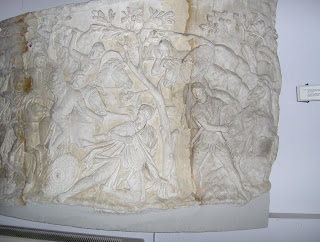
Another great image of where the Dacians lived...
We started our next day going to the remains of
Uplia Traiana Sarmisegetuza, that is the Roman town that was built sometime around 108-110 C.E. in the vicinity of the Dacian capital.(40 km) It is standing in the town of
Sarmisegetuza where we were housed. One thing that you notice right away is how Dacians liked to climb the mountains(1200m high) and the Romans loved lower, more spread out ground.(500m) The ruins were quite impressive: there is an amphitheater(but don't think Collusseum because it's 10 times smaller), 5 temples and a few hectars big forum. Pictures follow with explanations.

the entrance to the amphitheater. translation from the official slab:
"the amphitheater was a sort of stadium of our days, where the Romans could see a diversity of shows:
gladiator fights,
drama,
mime,
sports etc. it has an eclipse shape and a capacity of 5000 to 6000 spectators, but the places were occupied in a strictly social order. the amphitheater brings us important information about the period after the retreat of the Roman army and administration South of the Danube, when it as transformed into a fortress."
Click here for Birds-eye view 
These would have been the tiers for the audience.

A look of what the walls were made off. Probably basalt and limestone.

They said this was the temple of the goddess
Nemesis( actually this is the Greek name), who governed over the fair distribution of chance, and part of the housing for gladiators. In Roman mithology Nemesis was called
Invidia, translated as "to give what is due."

Another temple to . Notice the row of cut columns on the right. We learned from the locals that a lot of these were recycled ( read stolen ) because of their precious marble composition.

The well was still standing and is still being used. you must be from Romania to understand why someone would drink water from an ancient well that's supposedly in an archaeological site...

AHA! The robbers didn't get away with this column. Despite the fact that it's not very well kept the material is shiny white marble.

Someone must have been caught in the act of taking this one away. One of the things you'll notice is how badly kept the site is. I kept thinking to myself, why isn't this in a museum or restored somehow? My mother hypothesized that they are waiting for the earth to cover this site again so that someone more responsible and with more money will re-rediscover it. ha!

More from the same temple

This was used as a big storage. or Horrerum in Latin.

I think haystacks like these used to be here during the Dacians. I am half joking here, but goes to show how the town is integrated into the site.

THE FORUM....

Another pair of broken columns in the forum. and a pile of rocks waiting to be sorted.

My latin isn't what it used to be but this looks like a votive dedication. All in marble.

Assortment of capitols

Assortment of stones used in the city: marble, brick, basalt, limestone


Measuring up the votive dedication



I don't really know what these were except they had a vaulted ceiling and you went down 3 steps onto the grass....

Another mystey room in the forum. they don't do a good job of explaining what these are AND then they look like this....what???

Nice (almost) clean white marble.

People live right beside the site. here is someone's backyard. i was thinking some of those stones might even come from the forum.

I am a fan of the haystacks. Here you can see how the plots come right up to the archeological site.

I tried to visit the museum, but it was closed until the summer for renovation. wouldn't you know it? here are some missing shafts and an improvised bike rack.
 Dacian warriors with the Wolf Banner
Dacian warriors with the Wolf Banner This is how the copy fragments are displayed at the Museum of History in Bucharest
This is how the copy fragments are displayed at the Museum of History in Bucharest The scene of Decebalus' suicide: heroism or defeat?
The scene of Decebalus' suicide: heroism or defeat?  The much debated torture-scene: are the Romans torturing the Dacians or vice-versa?
The much debated torture-scene: are the Romans torturing the Dacians or vice-versa? The top of the Column copy in Bucharest
The top of the Column copy in Bucharest























































